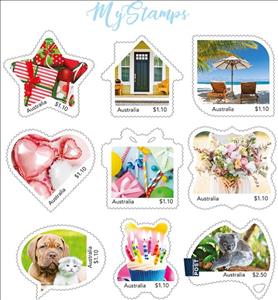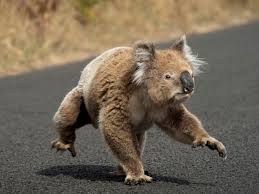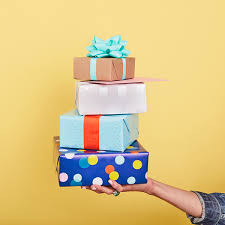Mini Sheet: MyStamp (2020 Collector Pane Printed in Offset Lithography) (Australia 2020)
MyStamp (2020 Collector Pane Printed in Offset Lithography) (Australia 2020)
08 January (Australia ) within release MyStamp Collectors Pack (2020) goes into circulation Mini Sheet MyStamp (2020 Collector Pane Printed in Offset Lithography) face value 11.30 Australian dollar
| Mini Sheet MyStamp (2020 Collector Pane Printed in Offset Lithography) in catalogues | |
|---|---|
| Colnect codes: | Col: AU 2020-03 |
Mini Sheet is square format.
Issued by Australia Post with set designs and face values for collectors, sold by Australia Post for Au$11.75. Printed by Offset Lithography while personalizable versions are printed by Digital Printing and can have variable designs and face values as chosen by customers.Also in the issue MyStamp Collectors Pack (2020):
- Mini Sheet - MyStamp (2020 Collector Pane Printed in Offset Lithography) face value 11.30;
- Stamp - Gifts face value 1.10;
- Stamp - House face value 1.10;
- Stamp - Beach Scene face value 1.10;
- Stamp - Hearts face value 1.10;
- Stamp - Gifts face value 1.10;
- Stamp - Bouquet face value 1.10;
- Stamp - Dog and Cat face value 1.10;
- Stamp - Cupcake face value 1.10;
- Stamp - Koala face value 2.50;
Mini Sheet MyStamp (2020 Collector Pane Printed in Offset Lithography) it reflects the thematic directions:
The domestic dog (Canis lupus familiaris or Canis familiaris) is a member of genus Canis (canines) that forms part of the wolf-like canids, and is the most widely abundant carnivore. The dog and the extant gray wolf are sister taxa, with modern wolves not closely related to the wolves that were first domesticated. The dog was the first domesticated species and has been selectively bred over millennia for various behaviors, sensory capabilities, and physical attributes. Their long association with humans has led dogs to be uniquely attuned to human behavior and they are able to thrive on a starch-rich diet that would be inadequate for other canid species. Dogs vary widely in shape, size and colours. Dogs perform many roles for people, such as hunting, herding, pulling loads, protection, assisting police and military, companionship and, more recently, aiding handicapped individuals. This influence on human society has given them the sobriquet "man's best friend".
A flower, sometimes known as a bloom or blossom, is the reproductive structure found in plants that are floral (plants of the division Magnoliophyta, also called angiosperms). The biological function of a flower is to effect reproduction, usually by providing a mechanism for the union of sperm with eggs. Flowers may facilitate outcrossing (fusion of sperm and eggs from different individuals in a population) or allow selfing (fusion of sperm and egg from the same flower). Some flowers produce diaspores without fertilization (parthenocarpy). Flowers contain sporangia and are the site where gametophytes develop. Many flowers have evolved to be attractive to animals, so as to cause them to be vectors for the transfer of pollen. After fertilization, the ovary of the flower develops into fruit containing seeds. In addition to facilitating the reproduction of flowering plants, flowers have long been admired and used by humans to beautify their environment, and also as objects of romance, ritual, religion, medicine and as a source of food.
The heart is a muscular organ found in most animals. This organ pumps blood through the blood vessels of the circulatory system.The pumped blood carries oxygen and nutrients to the body, while carrying metabolic waste such as carbon dioxide to the lungs.In humans, the heart is approximately the size of a closed fist and is located between the lungs, in the middle compartment of the chest, called the mediastinum.
The koala (Phascolarctos cinereus), sometimes called the koala bear, is an arboreal herbivorous marsupial native to Australia. It is the only extant representative of the family Phascolarctidae and its closest living relatives are the wombats. The koala is found in coastal areas of the mainland's eastern and southern regions, inhabiting Queensland, New South Wales, Victoria, and South Australia. It is easily recognisable by its stout, tailless body and large head with round, fluffy ears and large, dark nose. The koala has a body length of 60–85 cm (24–33 in) and weighs 4–15 kg (9–33 lb). Fur colour ranges from silver grey to chocolate brown. Koalas from the northern populations are typically smaller and lighter in colour than their counterparts further south. These populations possibly are separate subspecies, but this is disputed.
A gift or a present is an item given to someone, without the expectation of payment or anything in return. An item is not a gift if that item is already owned by the one to whom it is given. Although gift-giving might involve an expectation of reciprocity, a gift is meant to be free. In many countries, the act of mutually exchanging money, goods, etc. may sustain social relationship and contribute to social cohesion. Economists have elaborated the economics of gift-giving into the notion of a gift economy. By extension, the term gift can refer to any item or act of service that makes the other happier or less sad, especially as a favour, including forgiveness and kindness. Gifts are often presented on occasions such as birthdays and holidays.





